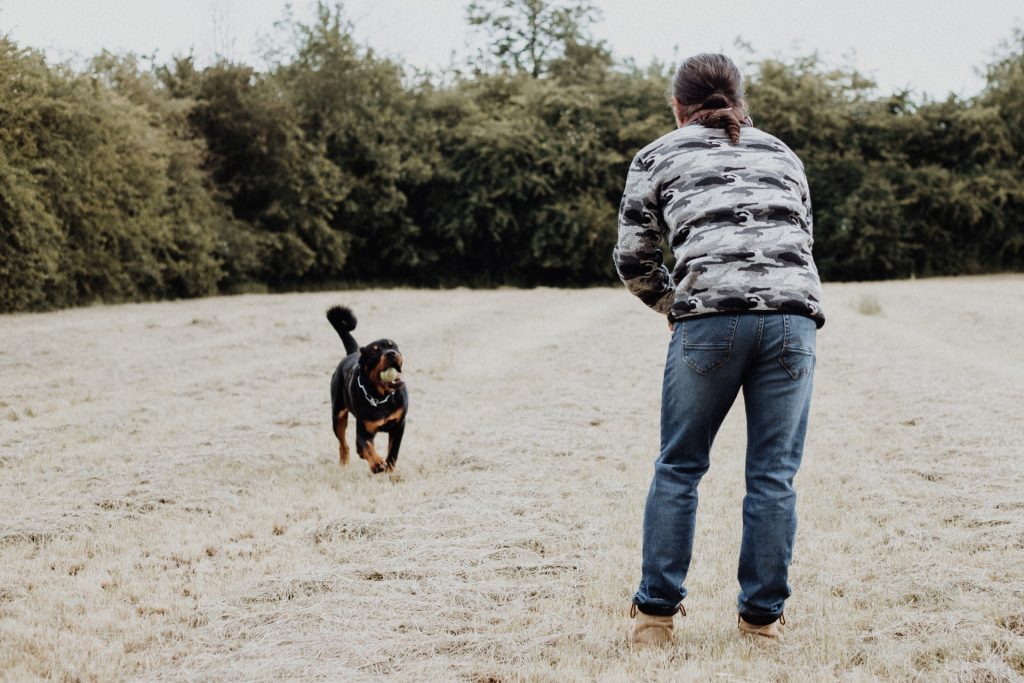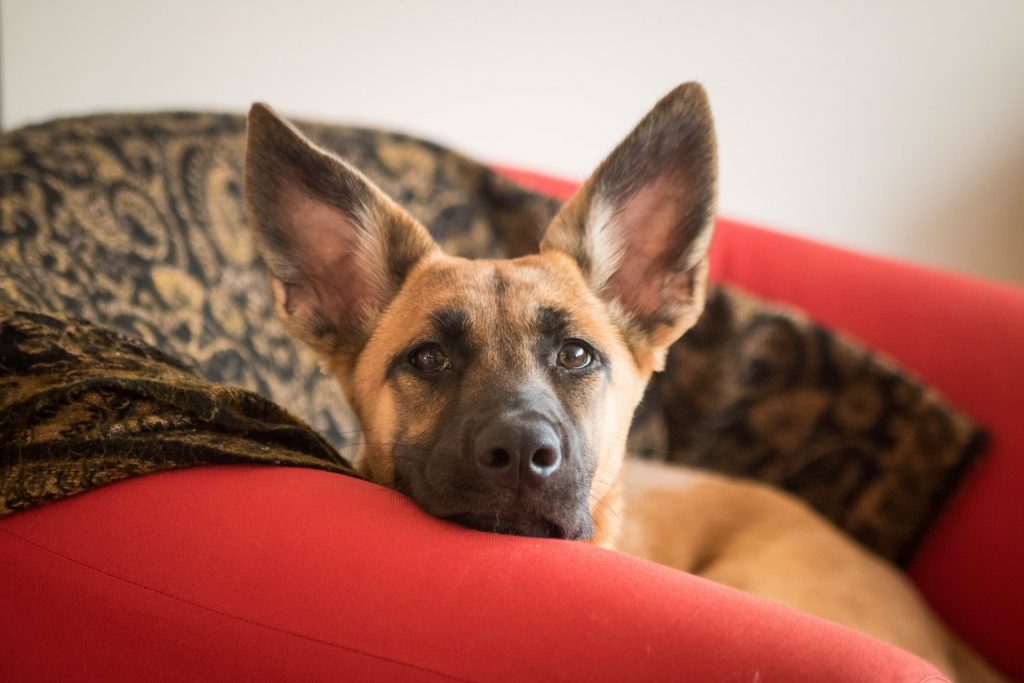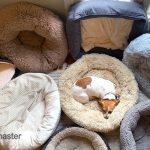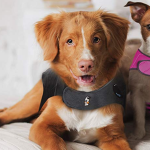
“Fido has been pacing back and forth and destroying my home while I’m away. He even attempted to escape the other day. Help! What’s happening?”
If your dog has any of these symptoms, your dog may have separation anxiety! This happens when a dog is extremely attached to its owner and becomes stressed when left alone, resulting in behaviors that are not common when you are home with them.
Signs Your Dog May Have Separation Anxiety
It’s important to distinguish between separation anxiety, incomplete puppy training, and possible medical issues to help your pup properly. If your dog has any of these symptoms only or primarily when they’re left alone – your dog may have separation anxiety. According to the ASPCA, some common symptoms include:
- Barking and Howling as soon as you leave
- Destruction in the home
- Urinating and Defecating
- Coprophagia (eating their stool)
- Escaping
- Pacing

Rule These Five Things Out First
It is very important to rule out any medical issues or common behaviors before pursing behavior modification for separation anxiety.
- Incontinence is a medical condition in which a dog “leaks”. Typically, they are unaware that they’ve soiled themselves. It’s best to look at possible urinary tract infections, hormone-related problems, bladder stones, diabetes, etc. Check in with your veterinarian to rule out these medical issues before attempting behavior modification.
- Submissive/Excitement Urination happens during greetings, play, physical contact, or when being reprimanded. Submissive dogs hold their tails low, flatten their ears against their head, crouch, etc. This is common in more timid dogs and is something you are already aware of.
- Urine Marking is when they mark their territory by urinating in small amounts on vertical surfaces such as corners. This allows them to show ownership over that item. Dogs that may occasionally pee in the home may have incomplete house training by either inconsistency or punishment involved in training. If Fido is still a puppy, this may be why they’re soiling themselves at home when you’re not around.
- Some dogs are destructive because they’re bored! We all need mental stimulation. They don’t appear anxious but are typically destructive in the home like ripping paper up, turning over furniture, etc. This can frustrate anyone coming home, but it can also be a sign Fido might need something to do when they’re home alone.
- Some dogs bark or howl excessively in response to unfamiliar environments. Police sirens, motorcycles, being crated suddenly, and skateboards are all great examples of this. If they’re barking and howling even when they’re in a comfortable environment, this may be a red flag.

How to Help Fido
It is best to receive guidance from a certified professional dog trainer when working on these tactics. Professionals can also provide more advice and make adjustments to the training as needed. Remember that every dog is different and they aren’t receptive to every training techniques.

Counterconditioning (per ASPCA)
This is a treatment process that changes an animal’s fearful or aggressive reaction to a pleasant and relaxed nature instead. This is typically done by associating the sight or presence of a feared or disliked person, animal, place, object, or situation with something the dog loves. Start by leaving them for VERY short periods and gradually lengthen the amount of time you’re gone. Using a cue word or phrase, such as “I’ll be back” can give them a safety cue to rely on while you’re away.
Take these steps:
- Start by leaving Fido for VERY short periods in their safe space. This can be a crate, playpen, bedroom, etc.
- Lead them to their safe space, and use a cue word or phrase such as “I’ll be back” to show that you’re leaving but will return.
- Sit on the couch or read a book in the same room. Whenever Fido is quiet, you can greet them and reward them calmly.
- Gradually lengthen the amount of time you’re gone.
- Once Fido is okay with you not being inside the room, every time you leave the house or go to another room without them, give your dog a puzzle toy stuffed with food or treats that will take them about 20-30 minutes to finish.
- Remove these toys as soon as you return.

Using a Radio or TV as a safety cue
This is an addition to counterconditioning for your pup. Start by training your dog to associate the radio or TV with positive things like a treat or praise. This takes the attention away from you. Soon, whenever you turn on the radio or tv, they’ll immediately calm down when they hear it.
Desensitization
Your dog will recognize your “departure cues” such as putting on your coat, picking up your keys or bag, putting on shoes, and this will typically set them off. We find that this is usually when the naughty behavior begins. Desensitizing is the process that treats emotional responsiveness to negative stimuli – or you leaving home! Some treatments include:
- Picking up your keys or putting on your coat, but then go make dinner instead of heading out
- Giving your pup a high value treat when you touch your keys or coat (also apart of counterconditioning)
- Put your dog in the crate and watch TV or read a book in the same room
Essentially, this almost tricks your dog into believing that these departure cues do not mean you are leaving. This typically goes hand in hand with counterconditioning to allow Fido to not be concerned with you leaving.
Exercise
This won’t necessarily CURE separation anxiety, but it can help. According to the AKC, recent research showed that lack of exercise could be a possible cause. Make sure your pup gets age-appropriate physical exercise. High-energy dogs have a lot of energy to burn off. Training sessions, puzzle toys, and cognitive games are excellent choices. A tired dog has less energy to be destructive. Try to end exercise sessions 20-30 minutes before you go, so Fido has time to relax for a nap.
Treating Clinginess
Play it cool when you return or leave home by making departures calm and emotionless. This is hard when you’ve had a long day and the only thing you want to do is cuddle your amazing dog. You can still do that! But for the first 15-20 minutes, allow Fido to calm down before giving them pets. If they get excited and jump all over you when you return, ignore them. Turn your back and walk away. Another option is to teach your dog how to “stay.” By teaching them tricks, it allows them to focus on something else other than how much they missed you!
Medication/Supplements
If you’ve ruled out any other medical issues, and training isn’t enough, check in with your vet. Some vets recommend medication that can treat depression, anxiety, or panic disorders. These medications require a prescription, so please do NOT use your own personal medication. There are also natural products available that can release calming pheromones or clothing that can induce calmness, such as a thunder jacket.
Keep this in mind!
It’s incredibly important to not give Fido the full-blown experience of separation anxiety. Otherwise, they won’t be able to learn to feel calm and comfortable without you being home. While starting your training, try some alternative methods:
- If possible, bring your dog to work with you.
- Have someone visit Fido in the home. This can be a family member, friend, or dog walker. We find that most times, they just want someone in the home with them to feel comfortable.
- Doggie daycare is a great option if Fido LOVES other dogs. This can allow them to exhaust themselves with their friends and come home satisfied/tired enough to not be overly excited to see you.

Five things NOT to do!
- Do not punish your pup. Punishment is not effective and can make the situation worse! This can cause your pup to associate your departures and arrivals with negativity and cause other behavioral problems that may be more destructive.
- Do not get another pet. Separation anxiety results from separation from YOU, not just the result of being alone. This is a completely different issue from isolation distress, which is when Fido does not enjoy being alone. If your pup is suffering from isolation distress, getting another furry friend may be helpful, but not necessarily a cure for separation anxiety.
- Do not crate your pup. Your pup can still engage in destructive behaviors inside the crate, especially as a punishment. It’s helpful to block off the crate and only expand as the pup grows, but Fido can still be destructive if they are very distressed about you not being home. The only time something like this would help is if we already consider the crate a safe space for your pup. This is something that you need to work on early on while crate training. If you notice signs of distress, do not crate your pup while you’re away.
- Do not use the radio or white noise (unless it’s a safety cue). Turning on the TV or radio won’t automatically cure Fido of separation anxiety. This goes hand in hand with counterconditioning. We must train Fido to view this as a safety cue. Using radio or white noise to “drown out” the barking and howling isn’t effective and may even confuse Fido more.
- Do not enroll Fido in obedience school. Separation anxiety does not mean your pup is disobedient or has a lack of training. It’s always a good idea to have formal training, but not for this specific issue. They are anxious because it separates them from YOU so sending them off to a school could even worsen this problem.

What Causes Separation Anxiety?
Never being left alone before
This often happens when the owner has been home a lot (for example, working from home because of COVID-19) and then suddenly returns to work for long periods.
Traumatic separation (occurs often in adopted shelter dogs)
Studies have shown animals surrendered can develop separation anxiety in a new home. The absence of their new owner triggers this panic of abandonment. This can also happen to dogs left with a boarding kennel while their parents are away for vacation. A new environment with unfamiliar smells, sounds, etc can trigger a panic since we’re not able to explain to Fido that we will be back.
Change in residence or family members
Moving is stressful for humans, so imagine what it’s like for Fido who doesn’t understand why they’re leaving their home! A change in family members can also cause separation anxiety, such as a new baby taking up most of the attention.
Your dog is naturally clingy
Naturally timid and clingy dogs tend to be more upset when the one human they trust is no longer in their presence. This is usually a personality trait you noticed when Fido first came home based on their behavior around new dogs, humans, etc.




Leave a Reply